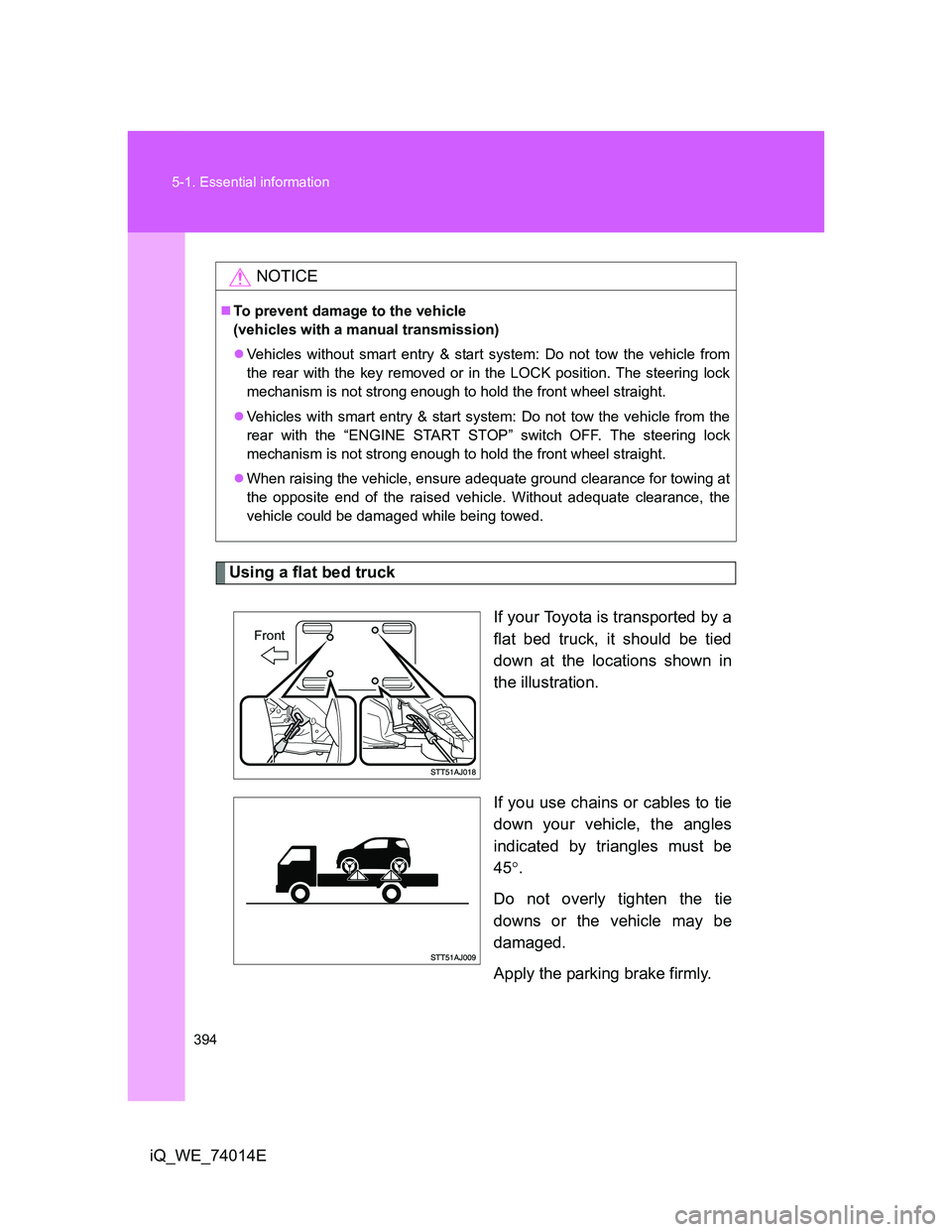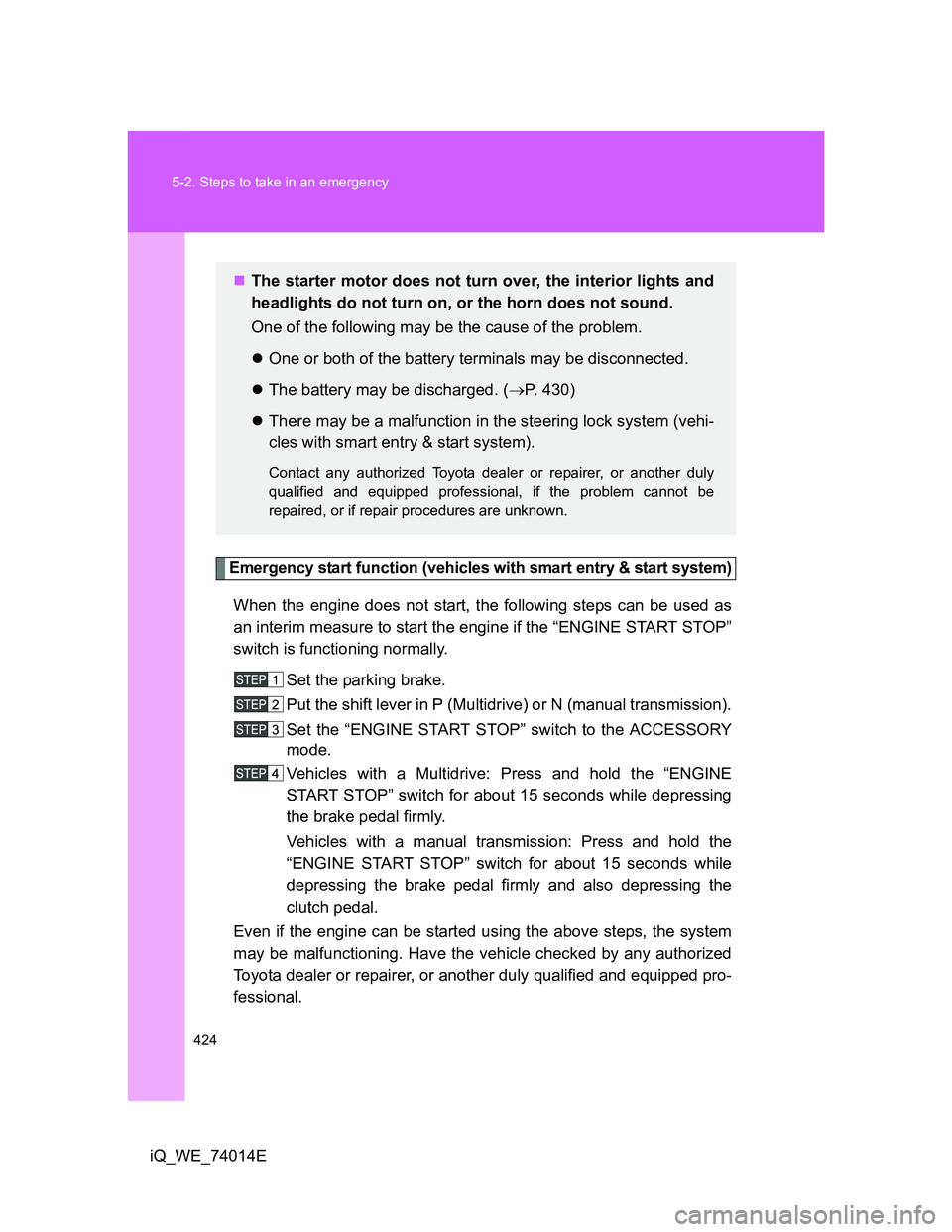Page 394 of 476

394 5-1. Essential information
iQ_WE_74014E
Using a flat bed truck
If your Toyota is transported by a
flat bed truck, it should be tied
down at the locations shown in
the illustration.
If you use chains or cables to tie
down your vehicle, the angles
indicated by triangles must be
45.
Do not overly tighten the tie
downs or the vehicle may be
damaged.
Apply the parking brake firmly.
NOTICE
To prevent damage to the vehicle
(vehicles with a manual transmission)
Vehicles without smart entry & start system: Do not tow the vehicle from
the rear with the key removed or in the LOCK position. The steering lock
mechanism is not strong enough to hold the front wheel straight.
Vehicles with smart entry & start system: Do not tow the vehicle from the
rear with the “ENGINE START STOP” switch OFF. The steering lock
mechanism is not strong enough to hold the front wheel straight.
When raising the vehicle, ensure adequate ground clearance for towing at
the opposite end of the raised vehicle. Without adequate clearance, the
vehicle could be damaged while being towed.
Front
Page 397 of 476

5
397
When trouble arises
iQ_WE_74014E
5-2. Steps to take in an emergency
If a war ning light tur ns on or a warning buzzer sounds...
Stop the vehicle immediately. Continuing to drive the vehicle may be dangerous.
The following warning indicates a possible problem in the brake sys-
tem. Immediately stop the vehicle in a safe place and contact any
authorized Toyota dealer or repairer, or another duly qualified and
equipped professional.
*: Parking brake engaged warning buzzer:
The buzzer sounds to indicate that parking brake is still engaged (with the
vehicle having reached a speed of 5 km/h [3 mph])
Warning lightWarning light/Details
Brake system warning light (warning buzzer)
*
• Low brake fluid
• Malfunction in the brake system
This light also comes on when the parking brake is not
released. If the light turns off after the parking brake is fully
released, the system is operating normally.
Calmly perform the following actions if any of the warning lights turn
on or flash. If a light turns on or flashes, but then turns off, this does
not necessarily indicate a malfunction in the system.
Page 405 of 476
5
405
5-2. Steps to take in an emergency
When trouble arises
iQ_WE_74014E
If you have a flat tire
A puncture caused by a nail or screw passing through the tire tread
can be repaired temporarily using the emergency tire puncture repair
kit. (The kit contains a bottle of sealant. The sealant can be used only
once to temporarily repair one tire without removing the nail or
screw from the tire.) After temporarily repairing the tire with the kit,
have the tire repaired or replaced by any authorized Toyota dealer or
repairer, or another duly qualified and equipped professional.
Before repairing the tire
Stop the vehicle in a safe place on a hard, flat surface.
Set the parking brake.
Shift the shift lever to P (Multidrive) or N (manual transmis-
sion).
Stop the engine.
Turn on the emergency flashers.
Location of the emergency tire puncture repair kit
Emergency tire
puncture repair kit
Page 424 of 476

424 5-2. Steps to take in an emergency
iQ_WE_74014E
Emergency start function (vehicles with smart entry & start system)
When the engine does not start, the following steps can be used as
an interim measure to start the engine if the “ENGINE START STOP”
switch is functioning normally.
Set the parking brake.
Put the shift lever in P (Multidrive) or N (manual transmission).
Set the “ENGINE START STOP” switch to the ACCESSORY
mode.
Vehicles with a Multidrive: Press and hold the “ENGINE
START STOP” switch for about 15 seconds while depressing
the brake pedal firmly.
Vehicles with a manual transmission: Press and hold the
“ENGINE START STOP” switch for about 15 seconds while
depressing the brake pedal firmly and also depressing the
clutch pedal.
Even if the engine can be started using the above steps, the system
may be malfunctioning. Have the vehicle checked by any authorized
Toyota dealer or repairer, or another duly qualified and equipped pro-
fessional.
The starter motor does not turn over, the interior lights and
headlights do not turn on, or the horn does not sound.
One of the following may be the cause of the problem.
One or both of the battery terminals may be disconnected.
The battery may be discharged. (P. 430)
There may be a malfunction in the steering lock system (vehi-
cles with smart entry & start system).
Contact any authorized Toyota dealer or repairer, or another duly
qualified and equipped professional, if the problem cannot be
repaired, or if repair procedures are unknown.
Page 425 of 476
5
425
5-2. Steps to take in an emergency
When trouble arises
iQ_WE_74014E
If the shift lever cannot be shifted from P (vehicles with a Multidrive)
If the shift lever cannot be shifted with your foot on the brake, there
may be a problem with the shift lock system (a system to prevent
accidental operation of the shift lever). Have the vehicle inspected by
any authorized Toyota dealer or repairer, or another duly qualified
and equipped professional, immediately.
The following steps may be used as an emergency measure to
ensure that the shift lever can be shifted.
Set the parking brake.
Vehicles without smart entry & start system: Turn the
engine switch to the ACC position.
Vehicles with smart entry & start system: Turn the “ENGINE
START STOP” switch to the ACCESSORY mode.
Depress the brake pedal.
Press the shift lock override
button.
The shift lever can be shifted
while the button is pressed.
Page 438 of 476
438
5-2. Steps to take in an emergency
iQ_WE_74014E
If the vehicle becomes stuck
Emergency hook
Carry out the following procedures if the tires spin or the vehicle
becomes stuck in mud, dirt, or snow.
Stop the engine. Set the parking brake and put the shift
lever in P (Multidrive) or N (manual transmission).
Remove the mud, snow, or sand from around the stuck tire.
Place wood, stones or some other material to help provide
traction under the tires.
Restart the engine.
Shift the shift lever to D or R (Multidrive) or 1 or R (manual
transmission) and carefully apply the accelerator to free the
vehicle.
Turn off the TRC and/or VSC systems if it is difficult to get out
because of TRC and/or VSC operation. (P. 225)
When your vehicle becomes stuck and
cannot move, the emergency hook is
used for another vehicle to pull your vehi-
cle out in an emergency.
Your vehicle is not designed to tow
another vehicle.
Page 455 of 476

455 6-1. Specifications
6
Vehicle specifications
iQ_WE_74014E
Brakes
*1: Minimum pedal clearance when depressed with a force of 300 N (30 kgf, 66
lbf) while the engine is running
*2: Parking brake lever travel when pulled up with a force of 200 N (20 kgf, 44
lbf)
Steering
Tires and wheels
Pedal clearance*1
Vehicles with rear drum brake
Vehicles with rear disc brake91 mm (3.58 in.) Min.
86 mm (3.39 in.) Min.
Pedal free play 1 6 mm (0.04 0.24 in.)
Parking brake lever travel*2
Vehicles with rear drum brake
Vehicles with rear disc brake6 9 clicks
5 8 clicks
Fluid type SAE J1703 or FMVSS No.116 DOT 3
Free play Less than 30 mm (1.2 in.)
Tire size 175/65R15 84S, 175/60R16 82H
Tire inflation pressure
(Recommended cold tire
inflation pressure)Vehicle
speedFront wheel
kPa (kgf/cm
2
or bar, psi)Rear wheel
kPa (kgf/cm2
or bar, psi)
More than
160 km/h
(100 mph)240 (2.4, 35) 230 (2.3, 33)
160 km/h
(100 mph)
or less230 (2.3, 33) 220 (2.2, 32)
Wheel size 15 5 J, 16 5 J
Wheel nut torque 103 N·m (10.5 kgf·m, 76 ft·lbf)
Page 463 of 476

463
iQ_WE_74014E
Alphabetical index
Alphabetical index
A/C..................................... 238, 244
ABS ........................................... 224
Air conditioning filter .............. 354
Air conditioning system
Air conditioning filter.............. 354
Automatic air conditioning
system ................................ 244
Manual air conditioning
system ................................ 238
Airbags
Airbag manual on-off
system ................................ 159
Airbag operating
conditions ........................... 127
Airbag precautions for
your child ............................ 132
Airbag warning light .............. 398
Curtain shield airbag
precautions ......................... 132
Knee airbag precautions ....... 132
Locations of airbags .............. 124
Modification and disposal
of airbags ............................ 136
Proper driving
posture........................ 122, 132
Rear window curtain shield
airbag precautions .............. 132
Seat cushion airbag
precautions ......................... 132
Side airbag precautions ........ 132
SRS airbag precautions ........ 132
SRS airbags .......................... 124
Alarm......................................... 119
Antenna ...................... 41, 264, 306
Anti-lock brake system ........... 224
Assist grips .............................. 298
Audio input ............................... 282Audio system
Antenna ................................ 264
Audio input ............................ 282
AUX port ............................... 282
CD player .............................. 265
MP3/WMA disc ..................... 272
Optimal use........................... 280
Portable music player ........... 282
Radio .................................... 260
Steering wheel audio
switch ................................. 284
Type ...................................... 257
Automatic air conditioning
system .................................... 244
Automatic light control
system .................................... 211
AUX port ................................... 282
Auxiliary box ............................ 290
Back-up lights
Replacing light bulbs............. 373
Wattage ................................ 456
Back door
Back door................................ 75
Smart entry & start system ..... 39
Wireless remote control .......... 62
Battery
Checking ............................... 342
If the vehicle battery
is discharged ...................... 430
Preparing and checking
before winter....................... 231
Bottle holder ............................ 289
Brakes
Parking brake........................ 194
Brake assist ............................. 224
Break-in tips ............................. 167A
B